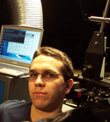|
|
 
|
|
Author
|
Topic: cable+pc
|
|
|
|
|
|
|
|
|
|
|
|
|
|
|
|
|
|
|
|
|
|
|
|
|
|
|
|
|
Ray Derrick
Master Film Handler

Posts: 310
From: Sydney, Australia
Registered: Sep 2001
|
 posted 02-11-2003 04:17 AM
posted 02-11-2003 04:17 AM




For anyone who has an interest in communicating serially with cinema processors (or any other serially controlled equipment), I have written a Windows program called "Serial Talk" which is a significant elaboration on the usual terminal programs and comes complete with pre-written command sets for most serially controllable equipment used in cinemas (like the Dolby CP500 & CP650, DTS6AD, as well as all Panalogic/Panastereo products, Kodak Ektapro slide machines, Panasonic LCD projectors etc etc).
The program allows you to send and receive commands very easily and is perfect for testing and debugging serial comms installations. If you would like to download a free copy, just go here and it is all yours.
If you find it useful, don't send thanks, just send money ![[Smile]](smile.gif)
If it crashes on you, I didn't write it, Bill Gates did! ![[Big Grin]](biggrin.gif)
[ 02-19-2003, 02:34 AM: Message edited by: Ray Derrick ]
| IP: Logged
|
|
|
|
All times are Central (GMT -6:00)
|
|
Powered by Infopop Corporation
UBB.classicTM
6.3.1.2
The Film-Tech Forums are designed for various members related to the cinema industry to express their opinions, viewpoints and testimonials on various products, services and events based upon speculation, personal knowledge and factual information through use, therefore all views represented here allow no liability upon the publishers of this web site and the owners of said views assume no liability for any ill will resulting from these postings. The posts made here are for educational as well as entertainment purposes and as such anyone viewing this portion of the website must accept these views as statements of the author of that opinion
and agrees to release the authors from any and all liability.
|

 Home
Home
 Products
Products
 Store
Store
 Forum
Forum
 Warehouse
Warehouse
 Contact Us
Contact Us




 Printer-friendly view of this topic
Printer-friendly view of this topic









![[Razz]](tongue.gif) DTS and SDDS both chose to be "the boss" (probably for egotistical reasons, sorry Karen) which is wrong because by convention, the attached PC, laptop or automation is really the boss!!
DTS and SDDS both chose to be "the boss" (probably for egotistical reasons, sorry Karen) which is wrong because by convention, the attached PC, laptop or automation is really the boss!!![[Big Grin]](biggrin.gif) ).
).


![[Smile]](smile.gif)



